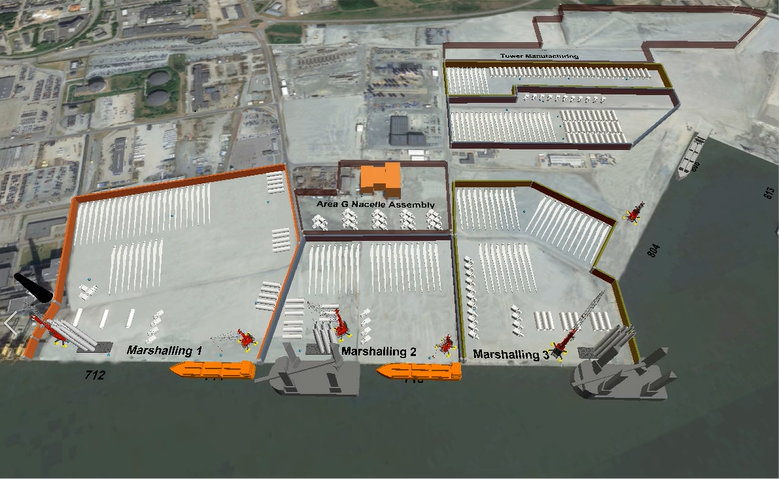Digital twin to help triple offshore wind shipping capacity at Port Esbjerg

Port Esbjerg is set to triple its annual offshore wind installations shipping capacity with the implementation of a digital twin. Esbjerg is the first port to get the digital twin, enabling it to calculate efficient methods for deploying offshore wind installation.
The digital tool will have a dramatic effect on the port’s wind capacity, as the port will be able to triple its annual shipping capacity for offshore wind installations from 1.5 GW to 4.5 GW. “It’s a gamechanger,” says Port Esbjerg CEO Dennis Jul Pedersen.
The annual amount of offshore wind capacity shipped from Esbjerg will triple within the next two years. The digital twin is a computer program that is fed huge amounts of data, enabling it to analyse all port processes related to the shipping of offshore wind installations, using a 1:1 simulation of the port. Everything from storage locations of wind components and space requirements to the impact of high tide and much more. In this way, all processes are optimised.
“Working with the digital twin is a gamechanger. We can make much better decisions using that tool. It means that we can triple our capacity at Port Esbjerg without expanding by a single square metre,” Jul Pedersen explains.
Port Esbjerg blazing the trail
Port capacity is one of the greatest challenges to the green transition. The pace must be stepped up significantly to reach the European offshore wind targets of at least 65 GW of offshore wind by 2030 and 340 GW by 2050.
“We’re now the first port in the world to have a digital twin for offshore wind. However, it could play a huge role in the deployment of wind installations across the whole of Europe in the coming years. There’s a lack of space at most wind ports in Europe, so we need to pull the ports out of our spreadsheets and create more digital twins instead,” says Jul Pedersen.
Working with digital twins to optimise, for example, container operations is nothing new. However, the deployment of wind installations tends to be more complex than other port processes, so optimising the design of these processes is extra important. There are many activities going on at the same time. For example, ships arrive from different countries bringing specialist equipment. This adds extra pieces to an already complicated puzzle. The capacity at Esbjerg will steadily increase from 1.5 GW to 4.5 GW per year by 2025, when the required changes will have been completed. This will include, for example, the rebuilding of various access roads.

A great achievement and a powerful tool
The US company Moffatt & Nichol developed the digital twin for Port Esbjerg. Moffatt & Nichol has a division focused exclusively on logistics and detailed design of offshore wind ports in Europe and the United States.
“It’s a great achievement that we’ve accomplished together, and one that we can definitely use here in the United States and elsewhere in Europe. The number of offshore wind installations we can push through in the future is truly impressive,” says Joshua Singer, a Marine Structure Engineer who was the project manager on the development of the digital twin.
“The ability to digitally develop the port and physically see the project happening gives you the opportunity to identify issues and efficiencies before any significant capital investments are made, and that’s a hugely powerful tool for the offshore wind industry,” says Singer.
The prospects are even greater
Jul Pedersen believes that the prospects of the project are even greater than just making port operations more efficient.
“Just imagine what we can achieve when we get suppliers entered into our digital twin. With nacelles from Cuxhaven and blades from Hull. There’s no reason to think we’ll stop at 4.5 GW, and the same goes for increasing capacity in the rest of Europe. And that’s before we even start expanding the ports,” Jul Pedersen emphasises.
You just read one of our premium articles free of charge
Want full access? Take advantage of our exclusive offer




